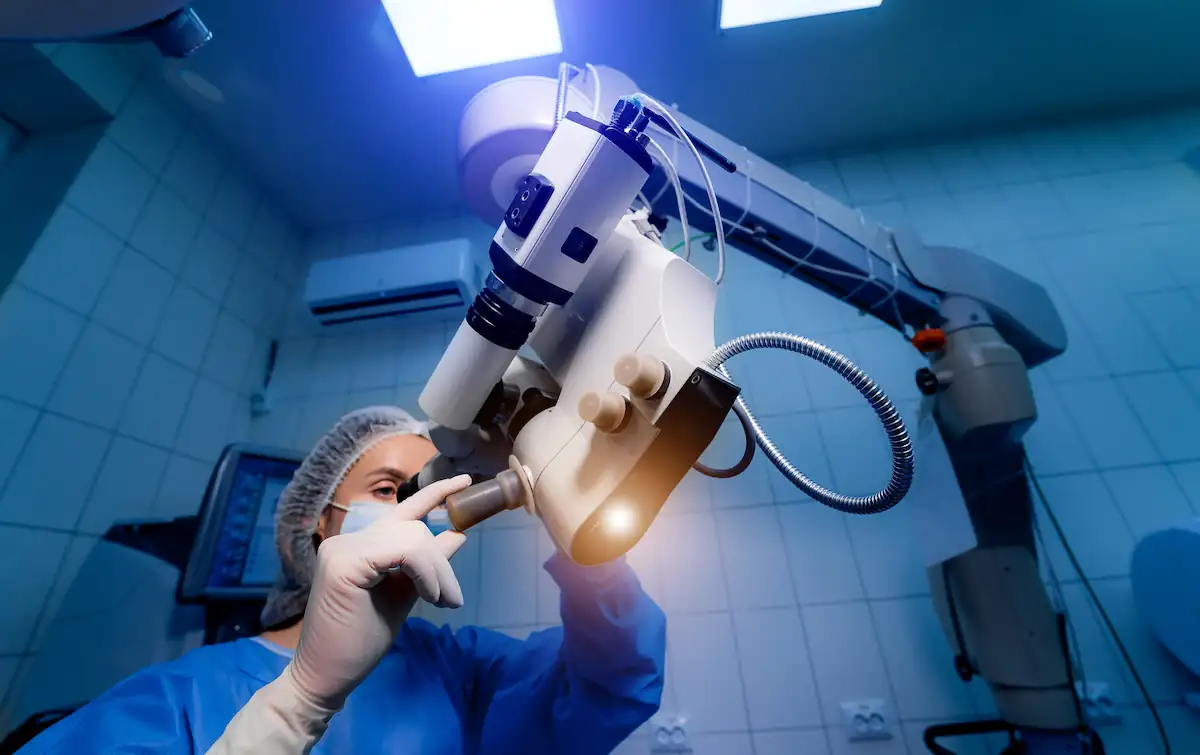PRK
Medically Reviewed by: Dr. Joseph King, MD – Board Certified Ophthalmologist, Diplomate of the American Board of Ophthalmology, Fellow of the American Academy of Ophthalmology
Last Updated: July 29, 2025
If you’re considering laser vision correction but aren’t a candidate for LASIK, PRK (photorefractive keratectomy) may be the ideal solution for achieving clear vision. At KingLASIK, we serve patients throughout Seattle, Spokane, Portland, Tacoma, Olympia, Vancouver, Everett, Tri-Cities, Scottsdale, and even Alaska with advanced PRK procedures performed by Dr. Joseph King, one of North America’s most experienced laser vision correction surgeons who has performed the most laser vision corrections in North America.
PRK offers the same exceptional vision correction results as LASIK but uses a different approach that makes it suitable for patients with thin corneas, irregular corneal shapes, or active lifestyles that may not be compatible with traditional LASIK surgery.
Meet Your PRK Surgeon
Dr. Joseph King, MD – Lead PRK Surgeon
Experience
One of North America’s most experienced laser vision correction surgeons with over 250,000+ procedures performed – the most laser vision corrections in North America.
Education & Training:
- Residency: Case Western Reserve, St. Luke’s Medical Center Cleveland
- Post-residency fellowship training: University of South Florida Eye Institute
- Medical Degree: University of British Columbia Faculty of Medicine
Board Certifications:
- Diplomate of the American Board of Ophthalmology
- Fellow of the American Academy of Ophthalmology
- Royal College of Physicians and Surgeons of Canada
Professional Memberships:
- American Academy of Ophthalmology
- American Society of Cataract and Refractive Surgery

What is PRK (Photorefractive Keratectomy)?
According to the American Academy of Ophthalmology, PRK was the first laser vision correction procedure developed and has been safely performed for over three decades with excellent long-term outcomes.1
How is PRK Performed?
The procedure steps:
- Prepare the eye with numbing drops for comfort
- Remove the epithelial layer using a specialized solution or gentle brushing technique
- Apply the excimer laser to reshape the cornea according to your prescription
- Place a protective contact lens to aid healing and comfort
- Complete the procedure in typically under 5 minutes per eye
The laser treatment itself takes less than one minute, making PRK an efficient outpatient procedure performed with the precision that comes from Dr. King’s extensive experience with over 250,000 laser vision corrections.

PRK vs LASIK: Understanding the Differences
While both PRK and LASIK achieve similar vision correction results, they differ in their surgical approach and recovery timeline:
PRK Advantages:
- Suitable for thin corneas where LASIK may not be safe
- No corneal flap complications since no flap is created2
- Ideal for active lifestyles with contact sports
- Long-term stability with excellent outcomes
LASIK Advantages:
- Faster visual recovery with most patients seeing clearly the next day
- Less post-operative discomfort during the healing process
- Quicker return to normal activities for most patients
Who is a Candidate for PRK?
We may recommend PRK if you have:
- Thin corneas that don’t meet LASIK safety requirements
- Irregular corneal shape or corneal scarring
- Active lifestyle with high-impact activities
- Dry eye syndrome that may be worsened by LASIK
PRK Candidacy Requirements:
- Age 18 or older with stable vision prescription
- Healthy corneas and overall eye health
- Realistic expectations about recovery timeline
- Commitment to post-operative care instructions
What to Expect During PRK Recovery
First 3-5 Days:
- Protective contact lens remains in place
- Some discomfort, light sensitivity, and tearing
- Vision may be blurry as epithelium regenerates
- Follow prescribed eye drop regimen
First 1-2 Weeks:
- Protective contact lens removed at follow-up visit
- Vision begins to improve significantly
- Most patients can return to work and normal activities
- Continue prescribed medications as directed
1-3 Months:
- Vision continues to sharpen and stabilize
- Most patients achieve their final visual outcome
- Regular follow-up appointments monitor healing progress
Advanced PRK Technology at King LASIK
Dr. King and the King LASIK surgeons utilize state-of-the-art excimer laser technology to ensure precise, customized treatment for each patient. Features include:
- Wavefront-guided treatment for personalized vision correction
- Eye tracking technology for enhanced accuracy during treatment
- Customized ablation patterns based on your unique corneal topography
- Advanced diagnostic equipment for comprehensive pre-operative evaluation
PRK Success Rates and Safety
PRK has an excellent safety profile with high patient satisfaction rates. According to peer-reviewed studies published in the Journal of Refractive Surgery, PRK demonstrates excellent long-term outcomes with minimal complications.3
Potential Risks and Complications
As with any surgical procedure, PRK carries some risks, though serious complications are rare. According to FDA data on refractive surgery, potential risks include:
- Light sensitivity during healing
- Halos or glare around lights
- Under or over-correction requiring enhancement
- Infection (very rare with proper care)
We will discuss all potential risks during your consultation and provide detailed informed consent information based on our extensive experience.
From Our Patients
“There isn’t one thing I didn’t LOVE about my experience with King LASIK. The staff, the painless procedure, the attentiveness”
– KingLASIK Patient
King LASIK Seattle Central
4.5/5 stars
229 reviews
King LASIK Vancouver
4.3/5 stars
31 reviews
Cost and Insurance Information
PRK costs vary based on individual treatment needs and technology used. During your consultation, we’ll provide detailed pricing information and discuss available financing options to make your vision correction investment affordable.
Many patients find that the long-term savings from reduced dependence on eyewear make PRK a valuable investment in their quality of life.
Office Locations and Contact Information
- King LASIK - Seattle North
- King LASIK -Seattle South
- King LASIK - Portland North
- King LASIK - Tri-Cities
- King LASIK - Seattle Central
- King LASIK - Portland South
- King LASIK - Scottsdale
King LASIK – Seattle North
King LASIK – Seattle South
King LASIK – Portland North
King LASIK – Tri-Cities
King LASIK – Seattle Central
King LASIK – Portland South
Schedule Your PRK Consultation King LASIK
Take the first step toward visual freedom with a comprehensive PRK evaluation. Our experienced team, led by Dr. King – one of North America’s most experienced laser vision correction surgeons – will provide exceptional care at all locations. During your consultation, we’ll:
- Perform detailed eye measurements and health assessment
- Discuss your vision goals and lifestyle needs
- Determine if PRK is the best option for your situation
- Answer all your questions about the procedure and recovery
- Provide personalized treatment recommendations based on our extensive experience
Contact KingLASIK today to schedule your consultation with an experienced eye surgeon at one of our convenient locations.
Frequently Asked Questions
Where can I find PRK near me?
KingLASIK offers PRK photorefractive keratectomy with Dr. Joseph King at multiple locations throughout Seattle, SpokanePortland, Tacoma, Olympia, Vancouver, Everett, Tri-Cities, Scottsdale, and Alaska. As one of North America’s most experienced laser vision correction surgeons with over 250,000 procedures performed, Dr. King provides personalized care ensuring you receive the highest quality treatment close to home.
Can I combine any other treatments with PRK?
PRK can often be combined with other vision correction procedures depending on your individual needs. Some patients benefit from combining PRK with treatments for presbyopia, such as monovision correction, or may be candidates for enhancement procedures if needed. During your consultation, we’ll discuss whether combining PRK with other refractive surgery options might optimize your visual outcomes.
How long does PRK last?
Is PRK painful?
Most patients experience mild to moderate discomfort for the first few days after PRK, which is well-managed with prescribed medications and protective contact lenses. The discomfort is temporary and significantly improves as the epithelium heals. Dr. King’s experience helps optimize comfort during recovery.
Can PRK treat astigmatism?
Yes, PRK effectively treats astigmatism along with nearsightedness and farsightedness. The excimer laser can be programmed to correct the irregular corneal shape that causes astigmatism, providing clear vision at all distances. Dr. King’s extensive experience ensures precise treatment of complex prescriptions including astigmatism.
Citations
1 American Academy of Ophthalmology. PRK. Available: https://www.aao.org/eye-health/treatments/photorefractive-keratectomy-prk. Accessed July 29, 2025.
2StatPearls. Photorefractive Keratectomy. https://www.ncbi.nlm.nih.gov/books/NBK549887/. Accessed July 29, 2025.
3 Vestergaard AH, Hjortdal JØ, Ivarsen A, Work K, Grauslund J, Sjølie AK. Long-term outcomes of photorefractive keratectomy for low to high myopia: 13 to 19 years of follow-up. J Refract Surg. 2013 May;29(5):312-9. doi: 10.3928/1081597X-20130415-02. PMID: 23659229. Available: https://pubmed.ncbi.nlm.nih.gov/23659229/. Accessed July 29, 2025.
4 Vestergaard AH, Hjortdal JØ, Ivarsen A, Work K, Grauslund J, Sjølie AK. Long-term outcomes of photorefractive keratectomy for low to high myopia: 13 to 19 years of follow-up. J Refract Surg. 2013 May;29(5):312-9. doi: 10.3928/1081597X-20130415-02. PMID: 23659229. Available: https://pubmed.ncbi.nlm.nih.gov/23659229/. Accessed July 29, 2025.
This information is for educational purposes only and should not replace professional medical advice. Individual results may vary. All surgical procedures carry risks. Please consult with Dr. King or a qualified ophthalmologist to determine if PRK is appropriate for your specific condition.




